UK Tax Policy and Analysis
VerifiedAdded on 2020/02/14
|15
|4528
|319
AI Summary
This assignment delves into various aspects of UK tax policy. It requires students to research and analyze current income tax rates, personal allowances, and the impact of taxation on business investment. The task also involves examining the effectiveness of tax incentives for innovation and exploring the relationship between taxation and technology-based small firms in the UK. Students are expected to utilize a range of resources including academic journals, government publications, and online databases.
Contribute Materials
Your contribution can guide someone’s learning journey. Share your
documents today.
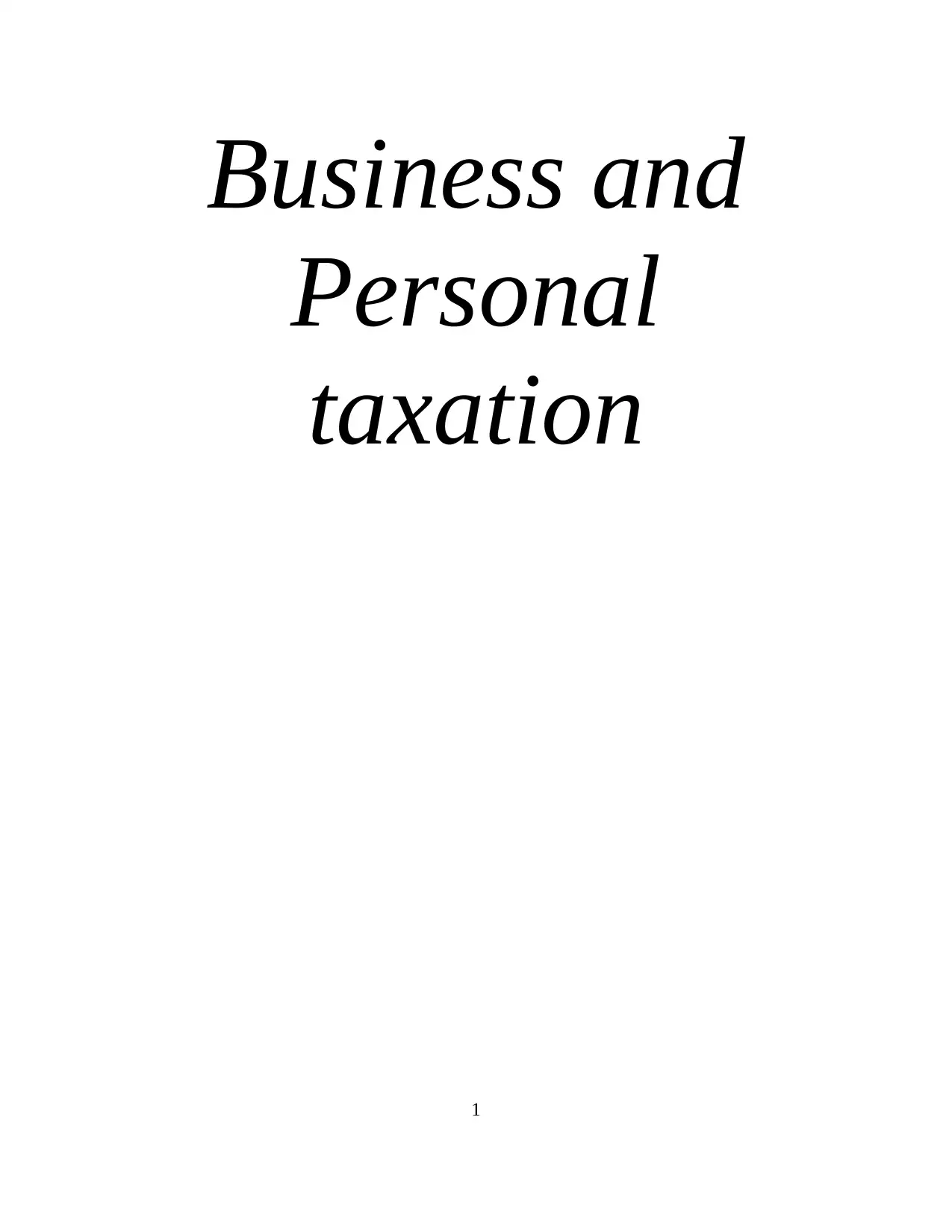
Business and
Personal
taxation
1
Personal
taxation
1
Secure Best Marks with AI Grader
Need help grading? Try our AI Grader for instant feedback on your assignments.
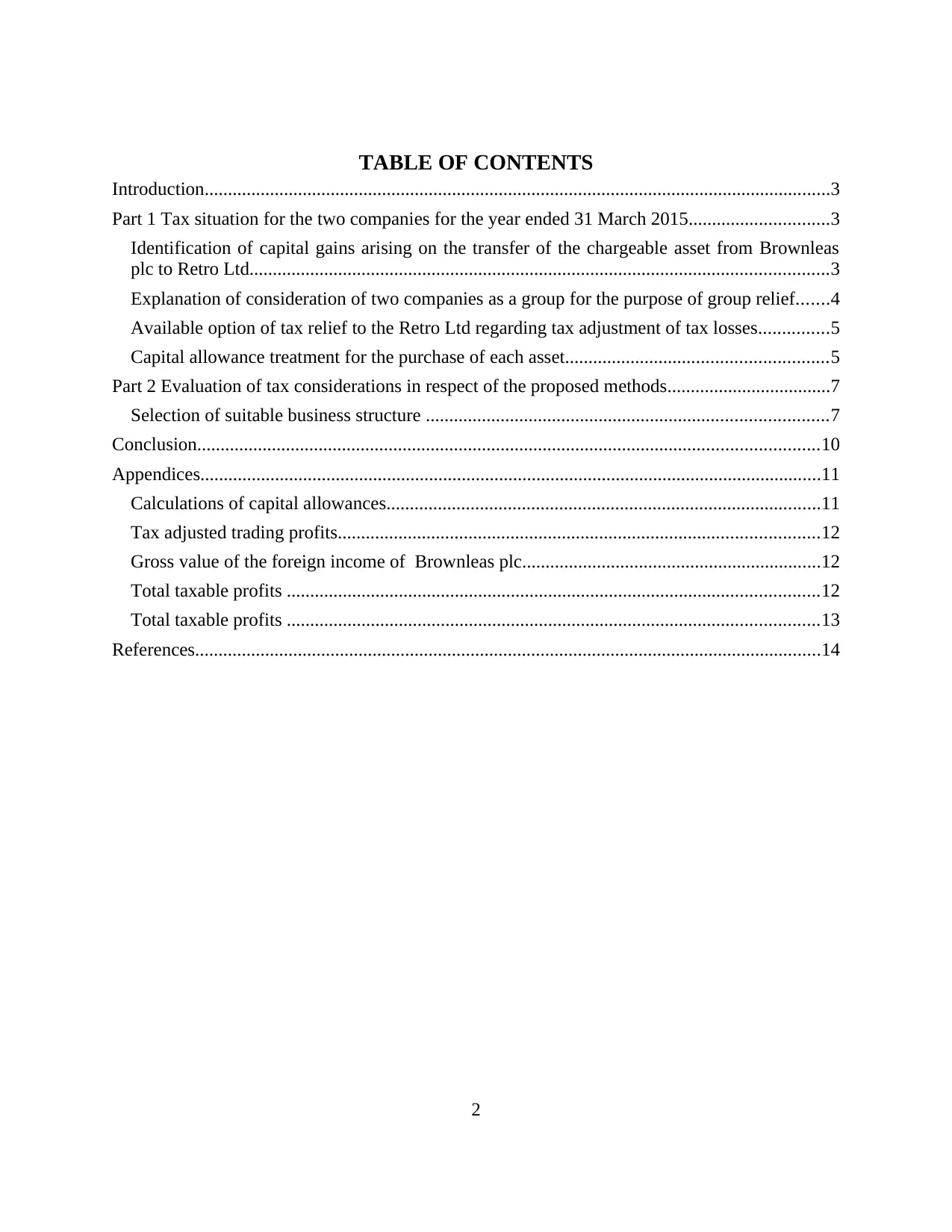
TABLE OF CONTENTS
Introduction......................................................................................................................................3
Part 1 Tax situation for the two companies for the year ended 31 March 2015..............................3
Identification of capital gains arising on the transfer of the chargeable asset from Brownleas
plc to Retro Ltd............................................................................................................................3
Explanation of consideration of two companies as a group for the purpose of group relief.......4
Available option of tax relief to the Retro Ltd regarding tax adjustment of tax losses...............5
Capital allowance treatment for the purchase of each asset........................................................5
Part 2 Evaluation of tax considerations in respect of the proposed methods...................................7
Selection of suitable business structure ......................................................................................7
Conclusion.....................................................................................................................................10
Appendices.....................................................................................................................................11
Calculations of capital allowances.............................................................................................11
Tax adjusted trading profits.......................................................................................................12
Gross value of the foreign income of Brownleas plc................................................................12
Total taxable profits ..................................................................................................................12
Total taxable profits ..................................................................................................................13
References......................................................................................................................................14
2
Introduction......................................................................................................................................3
Part 1 Tax situation for the two companies for the year ended 31 March 2015..............................3
Identification of capital gains arising on the transfer of the chargeable asset from Brownleas
plc to Retro Ltd............................................................................................................................3
Explanation of consideration of two companies as a group for the purpose of group relief.......4
Available option of tax relief to the Retro Ltd regarding tax adjustment of tax losses...............5
Capital allowance treatment for the purchase of each asset........................................................5
Part 2 Evaluation of tax considerations in respect of the proposed methods...................................7
Selection of suitable business structure ......................................................................................7
Conclusion.....................................................................................................................................10
Appendices.....................................................................................................................................11
Calculations of capital allowances.............................................................................................11
Tax adjusted trading profits.......................................................................................................12
Gross value of the foreign income of Brownleas plc................................................................12
Total taxable profits ..................................................................................................................12
Total taxable profits ..................................................................................................................13
References......................................................................................................................................14
2
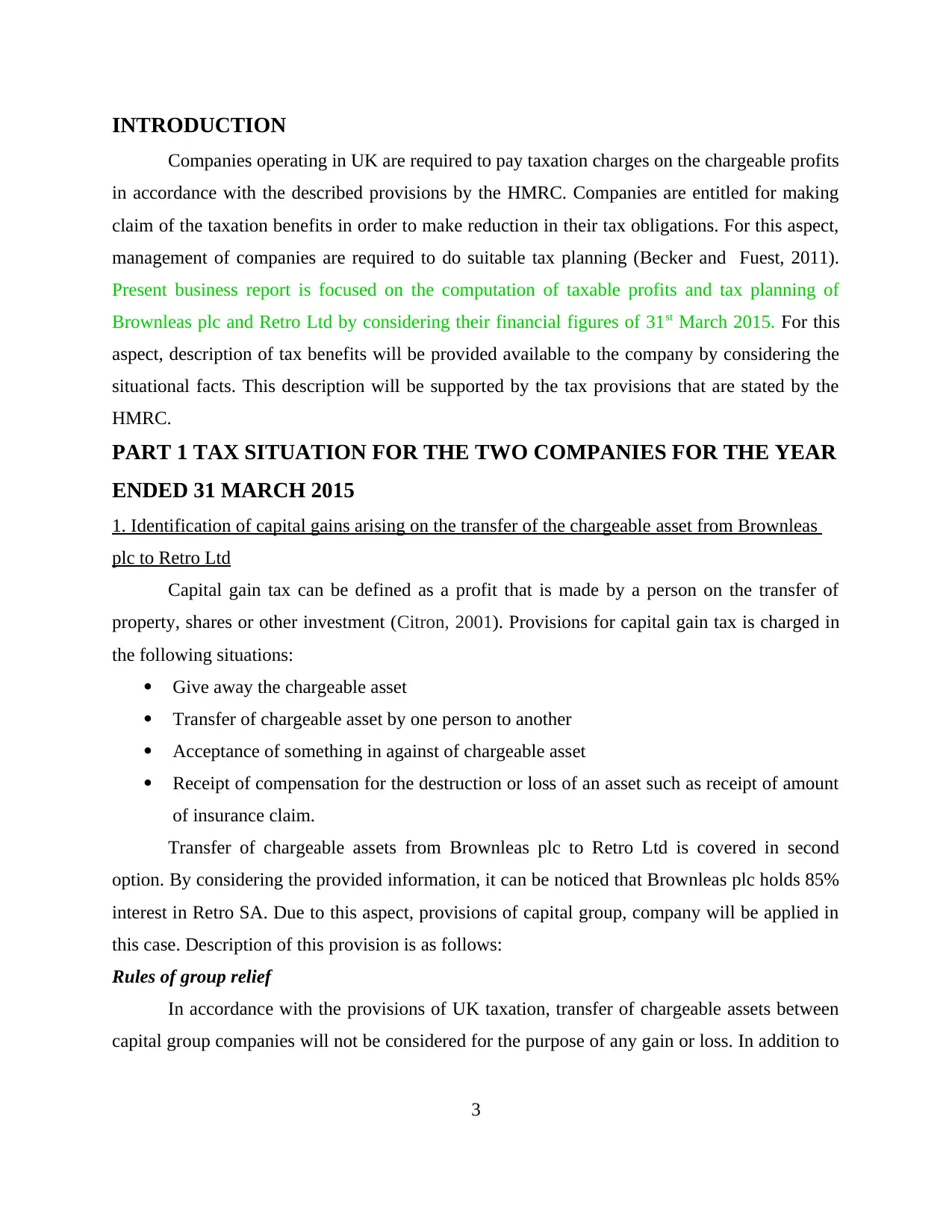
INTRODUCTION
Companies operating in UK are required to pay taxation charges on the chargeable profits
in accordance with the described provisions by the HMRC. Companies are entitled for making
claim of the taxation benefits in order to make reduction in their tax obligations. For this aspect,
management of companies are required to do suitable tax planning (Becker and Fuest, 2011).
Present business report is focused on the computation of taxable profits and tax planning of
Brownleas plc and Retro Ltd by considering their financial figures of 31st March 2015. For this
aspect, description of tax benefits will be provided available to the company by considering the
situational facts. This description will be supported by the tax provisions that are stated by the
HMRC.
PART 1 TAX SITUATION FOR THE TWO COMPANIES FOR THE YEAR
ENDED 31 MARCH 2015
1. Identification of capital gains arising on the transfer of the chargeable asset from Brownleas
plc to Retro Ltd
Capital gain tax can be defined as a profit that is made by a person on the transfer of
property, shares or other investment (Citron, 2001). Provisions for capital gain tax is charged in
the following situations:
Give away the chargeable asset
Transfer of chargeable asset by one person to another
Acceptance of something in against of chargeable asset
Receipt of compensation for the destruction or loss of an asset such as receipt of amount
of insurance claim.
Transfer of chargeable assets from Brownleas plc to Retro Ltd is covered in second
option. By considering the provided information, it can be noticed that Brownleas plc holds 85%
interest in Retro SA. Due to this aspect, provisions of capital group, company will be applied in
this case. Description of this provision is as follows:
Rules of group relief
In accordance with the provisions of UK taxation, transfer of chargeable assets between
capital group companies will not be considered for the purpose of any gain or loss. In addition to
3
Companies operating in UK are required to pay taxation charges on the chargeable profits
in accordance with the described provisions by the HMRC. Companies are entitled for making
claim of the taxation benefits in order to make reduction in their tax obligations. For this aspect,
management of companies are required to do suitable tax planning (Becker and Fuest, 2011).
Present business report is focused on the computation of taxable profits and tax planning of
Brownleas plc and Retro Ltd by considering their financial figures of 31st March 2015. For this
aspect, description of tax benefits will be provided available to the company by considering the
situational facts. This description will be supported by the tax provisions that are stated by the
HMRC.
PART 1 TAX SITUATION FOR THE TWO COMPANIES FOR THE YEAR
ENDED 31 MARCH 2015
1. Identification of capital gains arising on the transfer of the chargeable asset from Brownleas
plc to Retro Ltd
Capital gain tax can be defined as a profit that is made by a person on the transfer of
property, shares or other investment (Citron, 2001). Provisions for capital gain tax is charged in
the following situations:
Give away the chargeable asset
Transfer of chargeable asset by one person to another
Acceptance of something in against of chargeable asset
Receipt of compensation for the destruction or loss of an asset such as receipt of amount
of insurance claim.
Transfer of chargeable assets from Brownleas plc to Retro Ltd is covered in second
option. By considering the provided information, it can be noticed that Brownleas plc holds 85%
interest in Retro SA. Due to this aspect, provisions of capital group, company will be applied in
this case. Description of this provision is as follows:
Rules of group relief
In accordance with the provisions of UK taxation, transfer of chargeable assets between
capital group companies will not be considered for the purpose of any gain or loss. In addition to
3
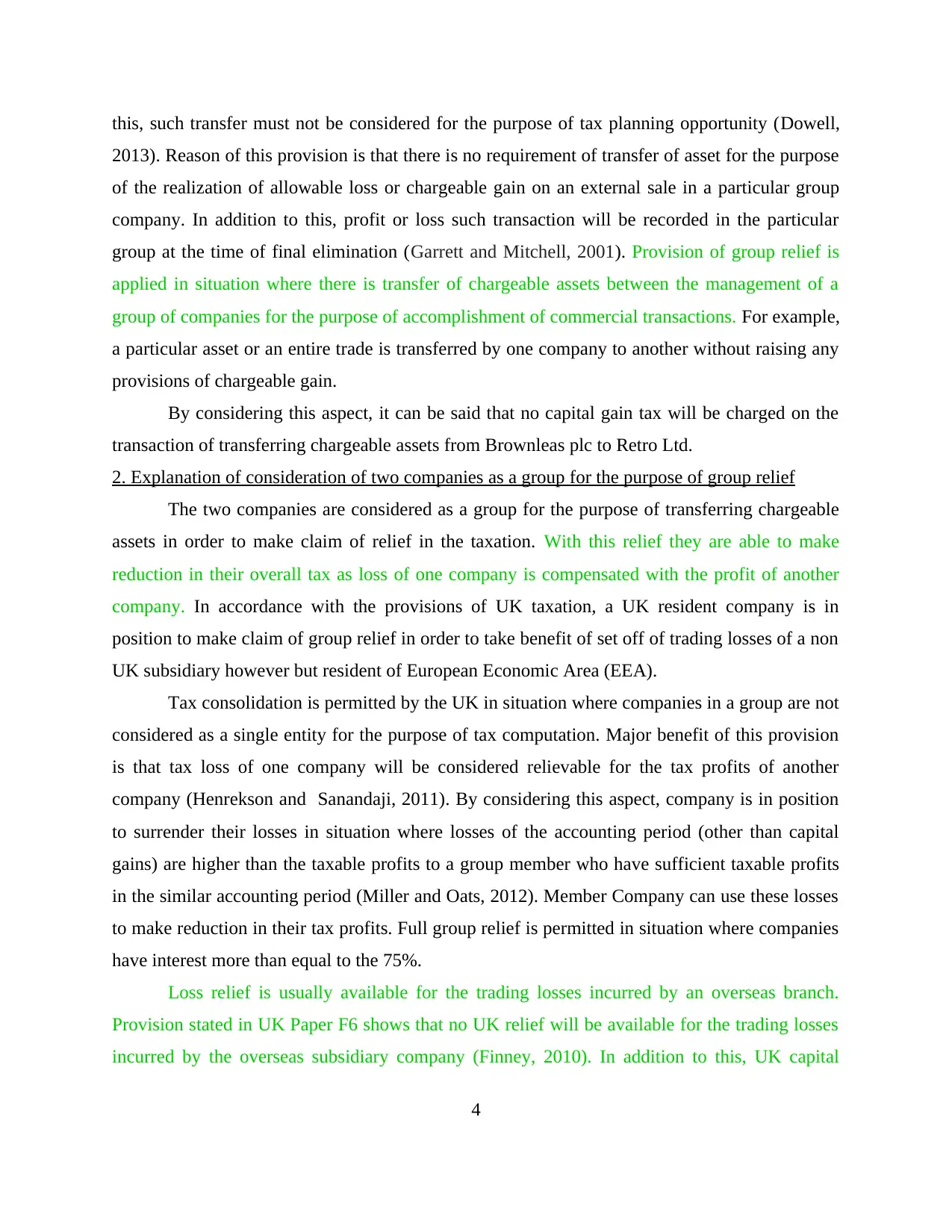
this, such transfer must not be considered for the purpose of tax planning opportunity (Dowell,
2013). Reason of this provision is that there is no requirement of transfer of asset for the purpose
of the realization of allowable loss or chargeable gain on an external sale in a particular group
company. In addition to this, profit or loss such transaction will be recorded in the particular
group at the time of final elimination (Garrett and Mitchell, 2001). Provision of group relief is
applied in situation where there is transfer of chargeable assets between the management of a
group of companies for the purpose of accomplishment of commercial transactions. For example,
a particular asset or an entire trade is transferred by one company to another without raising any
provisions of chargeable gain.
By considering this aspect, it can be said that no capital gain tax will be charged on the
transaction of transferring chargeable assets from Brownleas plc to Retro Ltd.
2. Explanation of consideration of two companies as a group for the purpose of group relief
The two companies are considered as a group for the purpose of transferring chargeable
assets in order to make claim of relief in the taxation. With this relief they are able to make
reduction in their overall tax as loss of one company is compensated with the profit of another
company. In accordance with the provisions of UK taxation, a UK resident company is in
position to make claim of group relief in order to take benefit of set off of trading losses of a non
UK subsidiary however but resident of European Economic Area (EEA).
Tax consolidation is permitted by the UK in situation where companies in a group are not
considered as a single entity for the purpose of tax computation. Major benefit of this provision
is that tax loss of one company will be considered relievable for the tax profits of another
company (Henrekson and Sanandaji, 2011). By considering this aspect, company is in position
to surrender their losses in situation where losses of the accounting period (other than capital
gains) are higher than the taxable profits to a group member who have sufficient taxable profits
in the similar accounting period (Miller and Oats, 2012). Member Company can use these losses
to make reduction in their tax profits. Full group relief is permitted in situation where companies
have interest more than equal to the 75%.
Loss relief is usually available for the trading losses incurred by an overseas branch.
Provision stated in UK Paper F6 shows that no UK relief will be available for the trading losses
incurred by the overseas subsidiary company (Finney, 2010). In addition to this, UK capital
4
2013). Reason of this provision is that there is no requirement of transfer of asset for the purpose
of the realization of allowable loss or chargeable gain on an external sale in a particular group
company. In addition to this, profit or loss such transaction will be recorded in the particular
group at the time of final elimination (Garrett and Mitchell, 2001). Provision of group relief is
applied in situation where there is transfer of chargeable assets between the management of a
group of companies for the purpose of accomplishment of commercial transactions. For example,
a particular asset or an entire trade is transferred by one company to another without raising any
provisions of chargeable gain.
By considering this aspect, it can be said that no capital gain tax will be charged on the
transaction of transferring chargeable assets from Brownleas plc to Retro Ltd.
2. Explanation of consideration of two companies as a group for the purpose of group relief
The two companies are considered as a group for the purpose of transferring chargeable
assets in order to make claim of relief in the taxation. With this relief they are able to make
reduction in their overall tax as loss of one company is compensated with the profit of another
company. In accordance with the provisions of UK taxation, a UK resident company is in
position to make claim of group relief in order to take benefit of set off of trading losses of a non
UK subsidiary however but resident of European Economic Area (EEA).
Tax consolidation is permitted by the UK in situation where companies in a group are not
considered as a single entity for the purpose of tax computation. Major benefit of this provision
is that tax loss of one company will be considered relievable for the tax profits of another
company (Henrekson and Sanandaji, 2011). By considering this aspect, company is in position
to surrender their losses in situation where losses of the accounting period (other than capital
gains) are higher than the taxable profits to a group member who have sufficient taxable profits
in the similar accounting period (Miller and Oats, 2012). Member Company can use these losses
to make reduction in their tax profits. Full group relief is permitted in situation where companies
have interest more than equal to the 75%.
Loss relief is usually available for the trading losses incurred by an overseas branch.
Provision stated in UK Paper F6 shows that no UK relief will be available for the trading losses
incurred by the overseas subsidiary company (Finney, 2010). In addition to this, UK capital
4
Secure Best Marks with AI Grader
Need help grading? Try our AI Grader for instant feedback on your assignments.
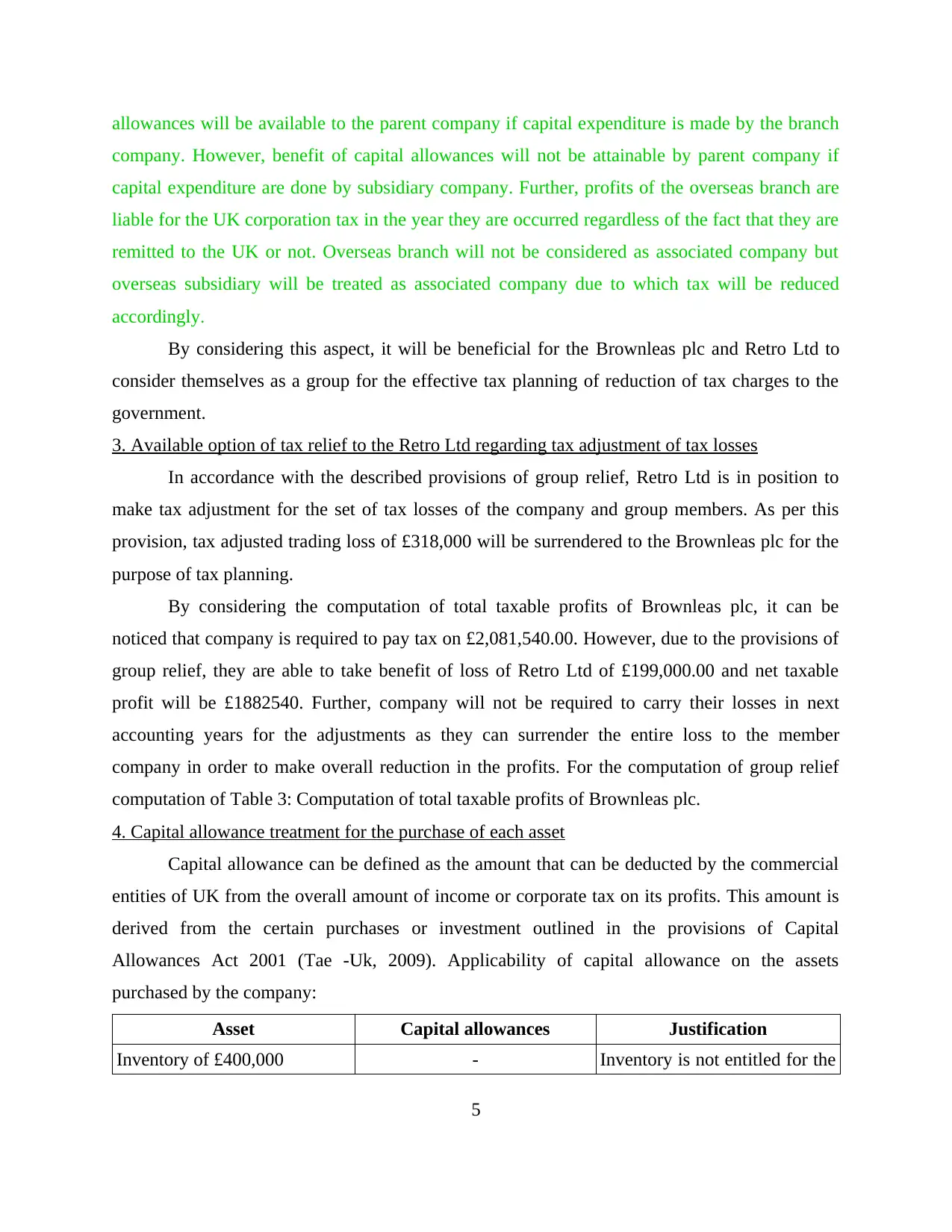
allowances will be available to the parent company if capital expenditure is made by the branch
company. However, benefit of capital allowances will not be attainable by parent company if
capital expenditure are done by subsidiary company. Further, profits of the overseas branch are
liable for the UK corporation tax in the year they are occurred regardless of the fact that they are
remitted to the UK or not. Overseas branch will not be considered as associated company but
overseas subsidiary will be treated as associated company due to which tax will be reduced
accordingly.
By considering this aspect, it will be beneficial for the Brownleas plc and Retro Ltd to
consider themselves as a group for the effective tax planning of reduction of tax charges to the
government.
3. Available option of tax relief to the Retro Ltd regarding tax adjustment of tax losses
In accordance with the described provisions of group relief, Retro Ltd is in position to
make tax adjustment for the set of tax losses of the company and group members. As per this
provision, tax adjusted trading loss of £318,000 will be surrendered to the Brownleas plc for the
purpose of tax planning.
By considering the computation of total taxable profits of Brownleas plc, it can be
noticed that company is required to pay tax on £2,081,540.00. However, due to the provisions of
group relief, they are able to take benefit of loss of Retro Ltd of £199,000.00 and net taxable
profit will be £1882540. Further, company will not be required to carry their losses in next
accounting years for the adjustments as they can surrender the entire loss to the member
company in order to make overall reduction in the profits. For the computation of group relief
computation of Table 3: Computation of total taxable profits of Brownleas plc.
4. Capital allowance treatment for the purchase of each asset
Capital allowance can be defined as the amount that can be deducted by the commercial
entities of UK from the overall amount of income or corporate tax on its profits. This amount is
derived from the certain purchases or investment outlined in the provisions of Capital
Allowances Act 2001 (Tae -Uk, 2009). Applicability of capital allowance on the assets
purchased by the company:
Asset Capital allowances Justification
Inventory of £400,000 - Inventory is not entitled for the
5
company. However, benefit of capital allowances will not be attainable by parent company if
capital expenditure are done by subsidiary company. Further, profits of the overseas branch are
liable for the UK corporation tax in the year they are occurred regardless of the fact that they are
remitted to the UK or not. Overseas branch will not be considered as associated company but
overseas subsidiary will be treated as associated company due to which tax will be reduced
accordingly.
By considering this aspect, it will be beneficial for the Brownleas plc and Retro Ltd to
consider themselves as a group for the effective tax planning of reduction of tax charges to the
government.
3. Available option of tax relief to the Retro Ltd regarding tax adjustment of tax losses
In accordance with the described provisions of group relief, Retro Ltd is in position to
make tax adjustment for the set of tax losses of the company and group members. As per this
provision, tax adjusted trading loss of £318,000 will be surrendered to the Brownleas plc for the
purpose of tax planning.
By considering the computation of total taxable profits of Brownleas plc, it can be
noticed that company is required to pay tax on £2,081,540.00. However, due to the provisions of
group relief, they are able to take benefit of loss of Retro Ltd of £199,000.00 and net taxable
profit will be £1882540. Further, company will not be required to carry their losses in next
accounting years for the adjustments as they can surrender the entire loss to the member
company in order to make overall reduction in the profits. For the computation of group relief
computation of Table 3: Computation of total taxable profits of Brownleas plc.
4. Capital allowance treatment for the purchase of each asset
Capital allowance can be defined as the amount that can be deducted by the commercial
entities of UK from the overall amount of income or corporate tax on its profits. This amount is
derived from the certain purchases or investment outlined in the provisions of Capital
Allowances Act 2001 (Tae -Uk, 2009). Applicability of capital allowance on the assets
purchased by the company:
Asset Capital allowances Justification
Inventory of £400,000 - Inventory is not entitled for the
5
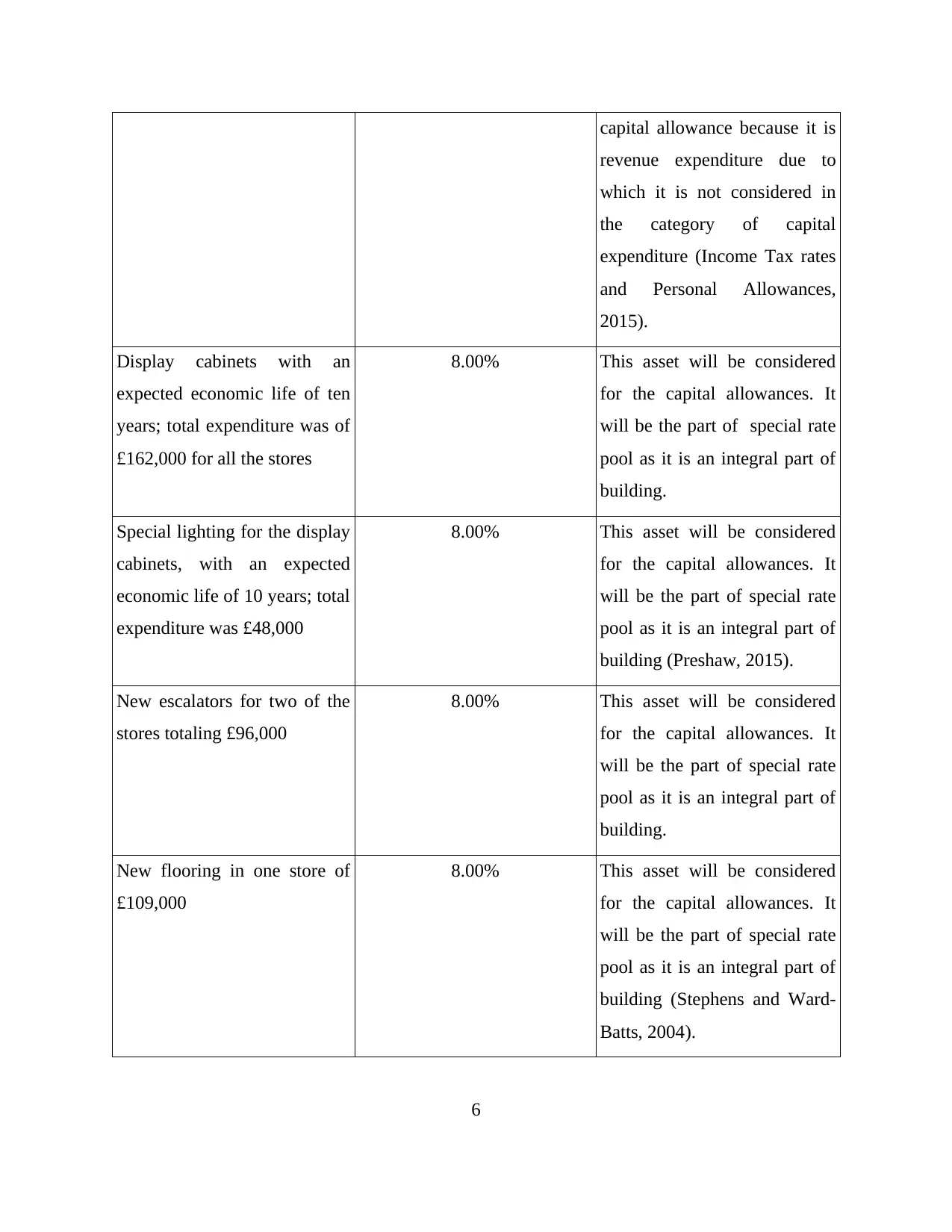
capital allowance because it is
revenue expenditure due to
which it is not considered in
the category of capital
expenditure (Income Tax rates
and Personal Allowances,
2015).
Display cabinets with an
expected economic life of ten
years; total expenditure was of
£162,000 for all the stores
8.00% This asset will be considered
for the capital allowances. It
will be the part of special rate
pool as it is an integral part of
building.
Special lighting for the display
cabinets, with an expected
economic life of 10 years; total
expenditure was £48,000
8.00% This asset will be considered
for the capital allowances. It
will be the part of special rate
pool as it is an integral part of
building (Preshaw, 2015).
New escalators for two of the
stores totaling £96,000
8.00% This asset will be considered
for the capital allowances. It
will be the part of special rate
pool as it is an integral part of
building.
New flooring in one store of
£109,000
8.00% This asset will be considered
for the capital allowances. It
will be the part of special rate
pool as it is an integral part of
building (Stephens and Ward-
Batts, 2004).
6
revenue expenditure due to
which it is not considered in
the category of capital
expenditure (Income Tax rates
and Personal Allowances,
2015).
Display cabinets with an
expected economic life of ten
years; total expenditure was of
£162,000 for all the stores
8.00% This asset will be considered
for the capital allowances. It
will be the part of special rate
pool as it is an integral part of
building.
Special lighting for the display
cabinets, with an expected
economic life of 10 years; total
expenditure was £48,000
8.00% This asset will be considered
for the capital allowances. It
will be the part of special rate
pool as it is an integral part of
building (Preshaw, 2015).
New escalators for two of the
stores totaling £96,000
8.00% This asset will be considered
for the capital allowances. It
will be the part of special rate
pool as it is an integral part of
building.
New flooring in one store of
£109,000
8.00% This asset will be considered
for the capital allowances. It
will be the part of special rate
pool as it is an integral part of
building (Stephens and Ward-
Batts, 2004).
6
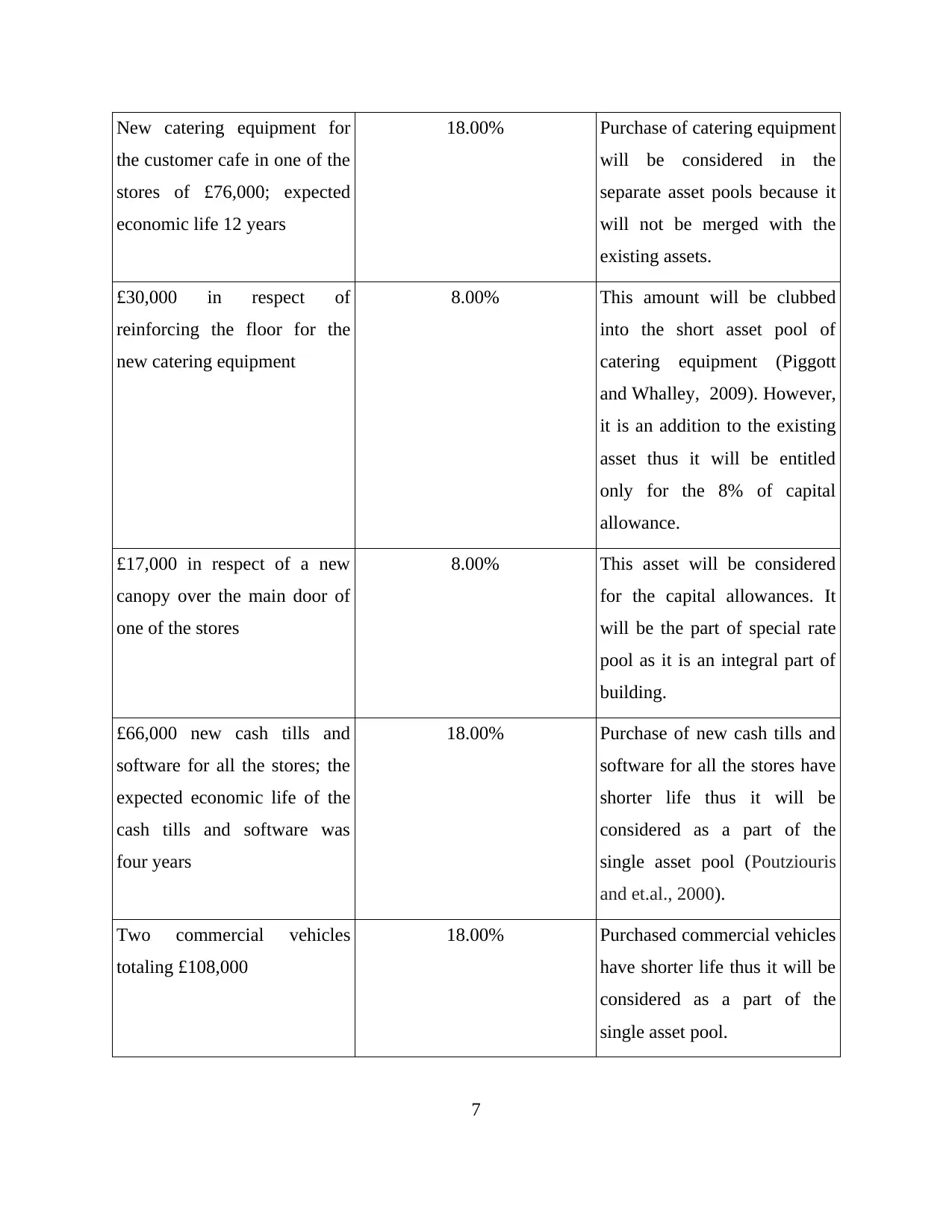
New catering equipment for
the customer cafe in one of the
stores of £76,000; expected
economic life 12 years
18.00% Purchase of catering equipment
will be considered in the
separate asset pools because it
will not be merged with the
existing assets.
£30,000 in respect of
reinforcing the floor for the
new catering equipment
8.00% This amount will be clubbed
into the short asset pool of
catering equipment (Piggott
and Whalley, 2009). However,
it is an addition to the existing
asset thus it will be entitled
only for the 8% of capital
allowance.
£17,000 in respect of a new
canopy over the main door of
one of the stores
8.00% This asset will be considered
for the capital allowances. It
will be the part of special rate
pool as it is an integral part of
building.
£66,000 new cash tills and
software for all the stores; the
expected economic life of the
cash tills and software was
four years
18.00% Purchase of new cash tills and
software for all the stores have
shorter life thus it will be
considered as a part of the
single asset pool (Poutziouris
and et.al., 2000).
Two commercial vehicles
totaling £108,000
18.00% Purchased commercial vehicles
have shorter life thus it will be
considered as a part of the
single asset pool.
7
the customer cafe in one of the
stores of £76,000; expected
economic life 12 years
18.00% Purchase of catering equipment
will be considered in the
separate asset pools because it
will not be merged with the
existing assets.
£30,000 in respect of
reinforcing the floor for the
new catering equipment
8.00% This amount will be clubbed
into the short asset pool of
catering equipment (Piggott
and Whalley, 2009). However,
it is an addition to the existing
asset thus it will be entitled
only for the 8% of capital
allowance.
£17,000 in respect of a new
canopy over the main door of
one of the stores
8.00% This asset will be considered
for the capital allowances. It
will be the part of special rate
pool as it is an integral part of
building.
£66,000 new cash tills and
software for all the stores; the
expected economic life of the
cash tills and software was
four years
18.00% Purchase of new cash tills and
software for all the stores have
shorter life thus it will be
considered as a part of the
single asset pool (Poutziouris
and et.al., 2000).
Two commercial vehicles
totaling £108,000
18.00% Purchased commercial vehicles
have shorter life thus it will be
considered as a part of the
single asset pool.
7
Paraphrase This Document
Need a fresh take? Get an instant paraphrase of this document with our AI Paraphraser
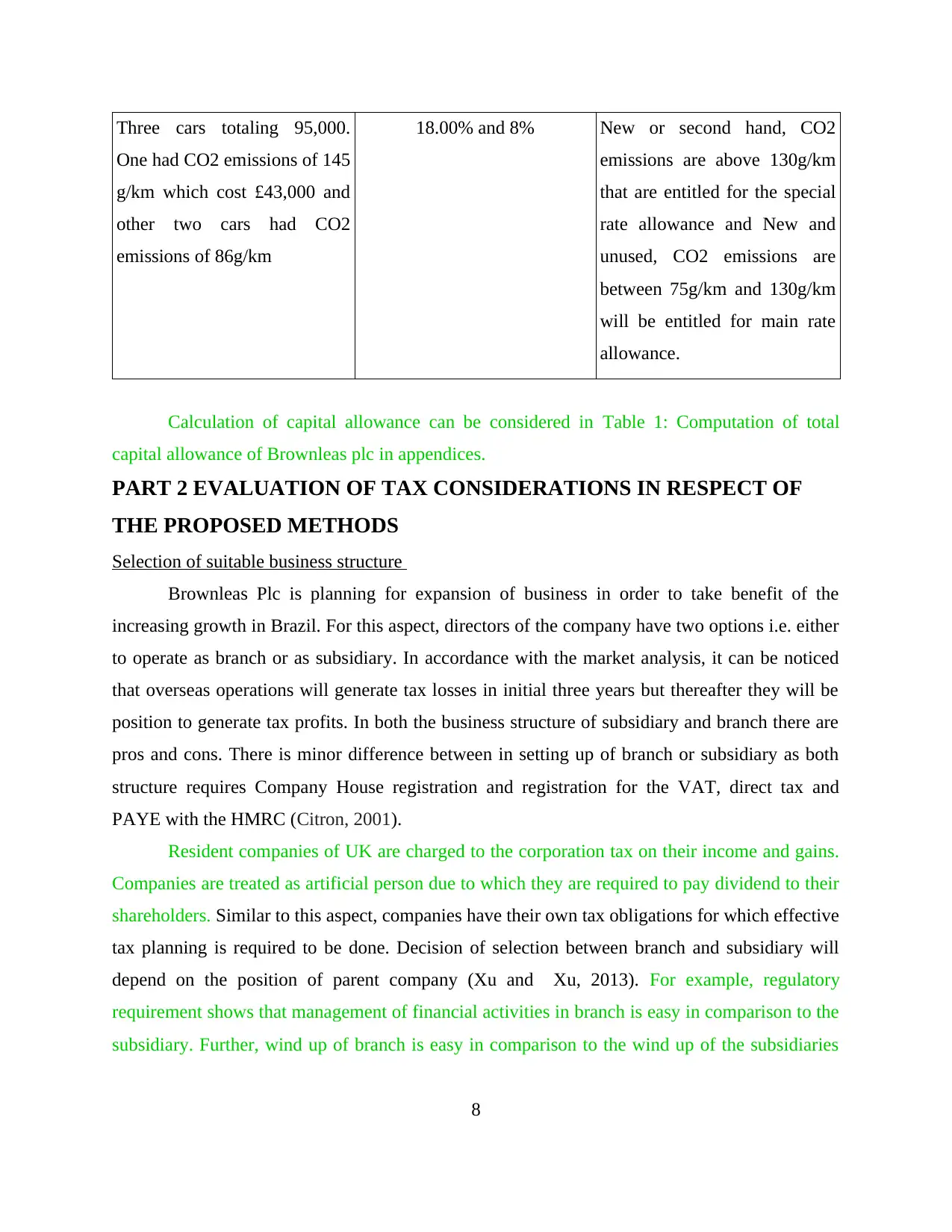
Three cars totaling 95,000.
One had CO2 emissions of 145
g/km which cost £43,000 and
other two cars had CO2
emissions of 86g/km
18.00% and 8% New or second hand, CO2
emissions are above 130g/km
that are entitled for the special
rate allowance and New and
unused, CO2 emissions are
between 75g/km and 130g/km
will be entitled for main rate
allowance.
Calculation of capital allowance can be considered in Table 1: Computation of total
capital allowance of Brownleas plc in appendices.
PART 2 EVALUATION OF TAX CONSIDERATIONS IN RESPECT OF
THE PROPOSED METHODS
Selection of suitable business structure
Brownleas Plc is planning for expansion of business in order to take benefit of the
increasing growth in Brazil. For this aspect, directors of the company have two options i.e. either
to operate as branch or as subsidiary. In accordance with the market analysis, it can be noticed
that overseas operations will generate tax losses in initial three years but thereafter they will be
position to generate tax profits. In both the business structure of subsidiary and branch there are
pros and cons. There is minor difference between in setting up of branch or subsidiary as both
structure requires Company House registration and registration for the VAT, direct tax and
PAYE with the HMRC (Citron, 2001).
Resident companies of UK are charged to the corporation tax on their income and gains.
Companies are treated as artificial person due to which they are required to pay dividend to their
shareholders. Similar to this aspect, companies have their own tax obligations for which effective
tax planning is required to be done. Decision of selection between branch and subsidiary will
depend on the position of parent company (Xu and Xu, 2013). For example, regulatory
requirement shows that management of financial activities in branch is easy in comparison to the
subsidiary. Further, wind up of branch is easy in comparison to the wind up of the subsidiaries
8
One had CO2 emissions of 145
g/km which cost £43,000 and
other two cars had CO2
emissions of 86g/km
18.00% and 8% New or second hand, CO2
emissions are above 130g/km
that are entitled for the special
rate allowance and New and
unused, CO2 emissions are
between 75g/km and 130g/km
will be entitled for main rate
allowance.
Calculation of capital allowance can be considered in Table 1: Computation of total
capital allowance of Brownleas plc in appendices.
PART 2 EVALUATION OF TAX CONSIDERATIONS IN RESPECT OF
THE PROPOSED METHODS
Selection of suitable business structure
Brownleas Plc is planning for expansion of business in order to take benefit of the
increasing growth in Brazil. For this aspect, directors of the company have two options i.e. either
to operate as branch or as subsidiary. In accordance with the market analysis, it can be noticed
that overseas operations will generate tax losses in initial three years but thereafter they will be
position to generate tax profits. In both the business structure of subsidiary and branch there are
pros and cons. There is minor difference between in setting up of branch or subsidiary as both
structure requires Company House registration and registration for the VAT, direct tax and
PAYE with the HMRC (Citron, 2001).
Resident companies of UK are charged to the corporation tax on their income and gains.
Companies are treated as artificial person due to which they are required to pay dividend to their
shareholders. Similar to this aspect, companies have their own tax obligations for which effective
tax planning is required to be done. Decision of selection between branch and subsidiary will
depend on the position of parent company (Xu and Xu, 2013). For example, regulatory
requirement shows that management of financial activities in branch is easy in comparison to the
subsidiary. Further, wind up of branch is easy in comparison to the wind up of the subsidiaries
8
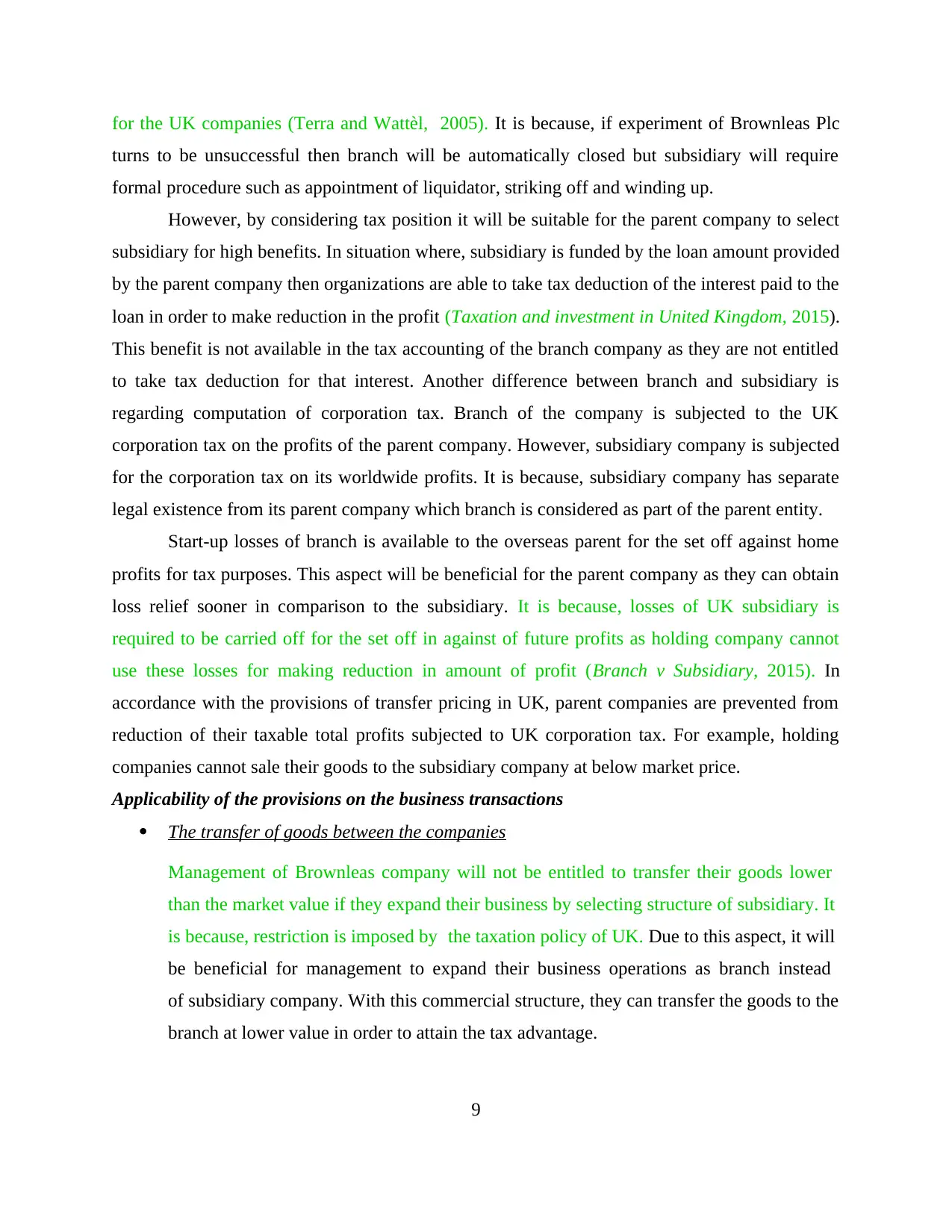
for the UK companies (Terra and Wattèl, 2005). It is because, if experiment of Brownleas Plc
turns to be unsuccessful then branch will be automatically closed but subsidiary will require
formal procedure such as appointment of liquidator, striking off and winding up.
However, by considering tax position it will be suitable for the parent company to select
subsidiary for high benefits. In situation where, subsidiary is funded by the loan amount provided
by the parent company then organizations are able to take tax deduction of the interest paid to the
loan in order to make reduction in the profit (Taxation and investment in United Kingdom, 2015).
This benefit is not available in the tax accounting of the branch company as they are not entitled
to take tax deduction for that interest. Another difference between branch and subsidiary is
regarding computation of corporation tax. Branch of the company is subjected to the UK
corporation tax on the profits of the parent company. However, subsidiary company is subjected
for the corporation tax on its worldwide profits. It is because, subsidiary company has separate
legal existence from its parent company which branch is considered as part of the parent entity.
Start-up losses of branch is available to the overseas parent for the set off against home
profits for tax purposes. This aspect will be beneficial for the parent company as they can obtain
loss relief sooner in comparison to the subsidiary. It is because, losses of UK subsidiary is
required to be carried off for the set off in against of future profits as holding company cannot
use these losses for making reduction in amount of profit (Branch v Subsidiary, 2015). In
accordance with the provisions of transfer pricing in UK, parent companies are prevented from
reduction of their taxable total profits subjected to UK corporation tax. For example, holding
companies cannot sale their goods to the subsidiary company at below market price.
Applicability of the provisions on the business transactions
The transfer of goods between the companies
Management of Brownleas company will not be entitled to transfer their goods lower
than the market value if they expand their business by selecting structure of subsidiary. It
is because, restriction is imposed by the taxation policy of UK. Due to this aspect, it will
be beneficial for management to expand their business operations as branch instead
of subsidiary company. With this commercial structure, they can transfer the goods to the
branch at lower value in order to attain the tax advantage.
9
turns to be unsuccessful then branch will be automatically closed but subsidiary will require
formal procedure such as appointment of liquidator, striking off and winding up.
However, by considering tax position it will be suitable for the parent company to select
subsidiary for high benefits. In situation where, subsidiary is funded by the loan amount provided
by the parent company then organizations are able to take tax deduction of the interest paid to the
loan in order to make reduction in the profit (Taxation and investment in United Kingdom, 2015).
This benefit is not available in the tax accounting of the branch company as they are not entitled
to take tax deduction for that interest. Another difference between branch and subsidiary is
regarding computation of corporation tax. Branch of the company is subjected to the UK
corporation tax on the profits of the parent company. However, subsidiary company is subjected
for the corporation tax on its worldwide profits. It is because, subsidiary company has separate
legal existence from its parent company which branch is considered as part of the parent entity.
Start-up losses of branch is available to the overseas parent for the set off against home
profits for tax purposes. This aspect will be beneficial for the parent company as they can obtain
loss relief sooner in comparison to the subsidiary. It is because, losses of UK subsidiary is
required to be carried off for the set off in against of future profits as holding company cannot
use these losses for making reduction in amount of profit (Branch v Subsidiary, 2015). In
accordance with the provisions of transfer pricing in UK, parent companies are prevented from
reduction of their taxable total profits subjected to UK corporation tax. For example, holding
companies cannot sale their goods to the subsidiary company at below market price.
Applicability of the provisions on the business transactions
The transfer of goods between the companies
Management of Brownleas company will not be entitled to transfer their goods lower
than the market value if they expand their business by selecting structure of subsidiary. It
is because, restriction is imposed by the taxation policy of UK. Due to this aspect, it will
be beneficial for management to expand their business operations as branch instead
of subsidiary company. With this commercial structure, they can transfer the goods to the
branch at lower value in order to attain the tax advantage.
9
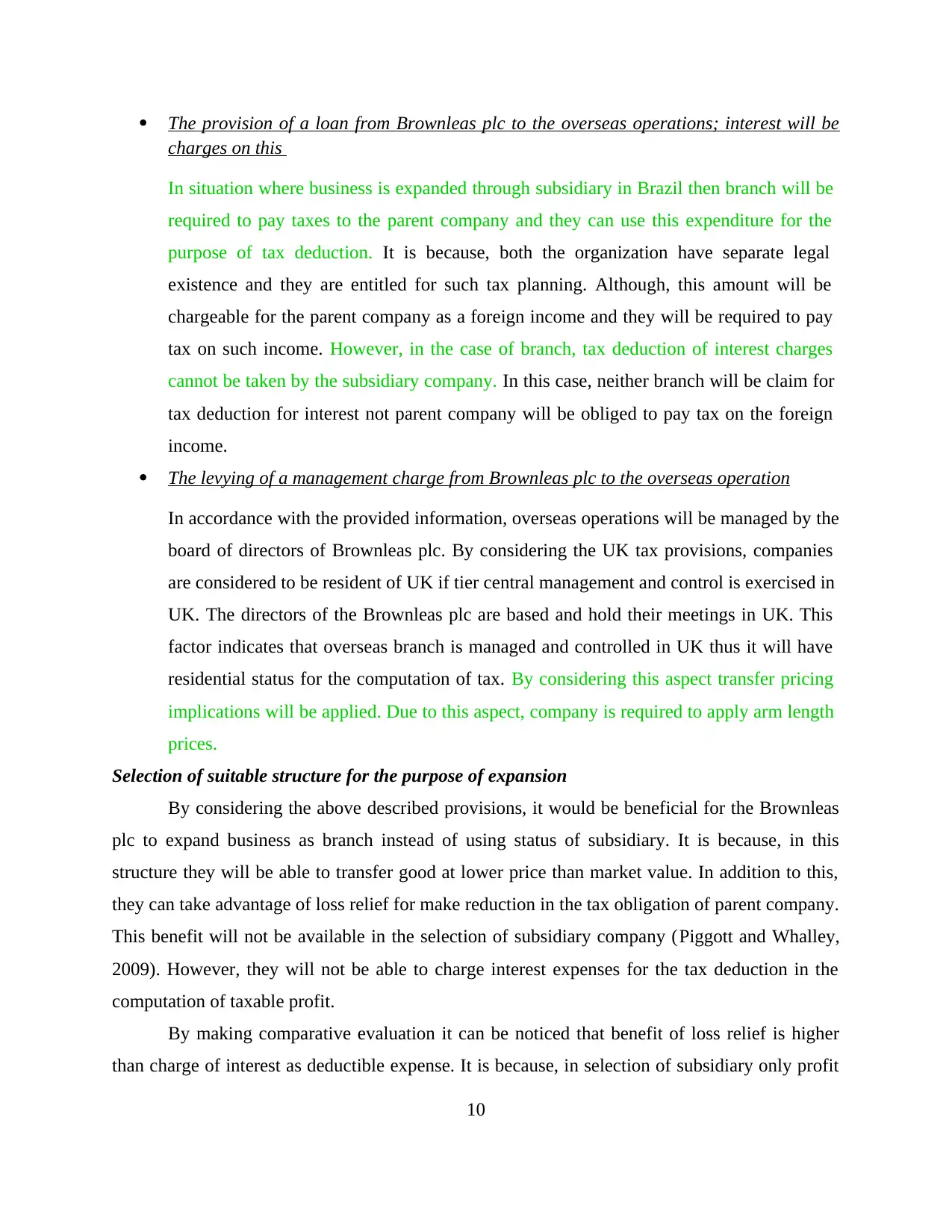
The provision of a loan from Brownleas plc to the overseas operations; interest will be
charges on this
In situation where business is expanded through subsidiary in Brazil then branch will be
required to pay taxes to the parent company and they can use this expenditure for the
purpose of tax deduction. It is because, both the organization have separate legal
existence and they are entitled for such tax planning. Although, this amount will be
chargeable for the parent company as a foreign income and they will be required to pay
tax on such income. However, in the case of branch, tax deduction of interest charges
cannot be taken by the subsidiary company. In this case, neither branch will be claim for
tax deduction for interest not parent company will be obliged to pay tax on the foreign
income.
The levying of a management charge from Brownleas plc to the overseas operation
In accordance with the provided information, overseas operations will be managed by the
board of directors of Brownleas plc. By considering the UK tax provisions, companies
are considered to be resident of UK if tier central management and control is exercised in
UK. The directors of the Brownleas plc are based and hold their meetings in UK. This
factor indicates that overseas branch is managed and controlled in UK thus it will have
residential status for the computation of tax. By considering this aspect transfer pricing
implications will be applied. Due to this aspect, company is required to apply arm length
prices.
Selection of suitable structure for the purpose of expansion
By considering the above described provisions, it would be beneficial for the Brownleas
plc to expand business as branch instead of using status of subsidiary. It is because, in this
structure they will be able to transfer good at lower price than market value. In addition to this,
they can take advantage of loss relief for make reduction in the tax obligation of parent company.
This benefit will not be available in the selection of subsidiary company (Piggott and Whalley,
2009). However, they will not be able to charge interest expenses for the tax deduction in the
computation of taxable profit.
By making comparative evaluation it can be noticed that benefit of loss relief is higher
than charge of interest as deductible expense. It is because, in selection of subsidiary only profit
10
charges on this
In situation where business is expanded through subsidiary in Brazil then branch will be
required to pay taxes to the parent company and they can use this expenditure for the
purpose of tax deduction. It is because, both the organization have separate legal
existence and they are entitled for such tax planning. Although, this amount will be
chargeable for the parent company as a foreign income and they will be required to pay
tax on such income. However, in the case of branch, tax deduction of interest charges
cannot be taken by the subsidiary company. In this case, neither branch will be claim for
tax deduction for interest not parent company will be obliged to pay tax on the foreign
income.
The levying of a management charge from Brownleas plc to the overseas operation
In accordance with the provided information, overseas operations will be managed by the
board of directors of Brownleas plc. By considering the UK tax provisions, companies
are considered to be resident of UK if tier central management and control is exercised in
UK. The directors of the Brownleas plc are based and hold their meetings in UK. This
factor indicates that overseas branch is managed and controlled in UK thus it will have
residential status for the computation of tax. By considering this aspect transfer pricing
implications will be applied. Due to this aspect, company is required to apply arm length
prices.
Selection of suitable structure for the purpose of expansion
By considering the above described provisions, it would be beneficial for the Brownleas
plc to expand business as branch instead of using status of subsidiary. It is because, in this
structure they will be able to transfer good at lower price than market value. In addition to this,
they can take advantage of loss relief for make reduction in the tax obligation of parent company.
This benefit will not be available in the selection of subsidiary company (Piggott and Whalley,
2009). However, they will not be able to charge interest expenses for the tax deduction in the
computation of taxable profit.
By making comparative evaluation it can be noticed that benefit of loss relief is higher
than charge of interest as deductible expense. It is because, in selection of subsidiary only profit
10
Secure Best Marks with AI Grader
Need help grading? Try our AI Grader for instant feedback on your assignments.
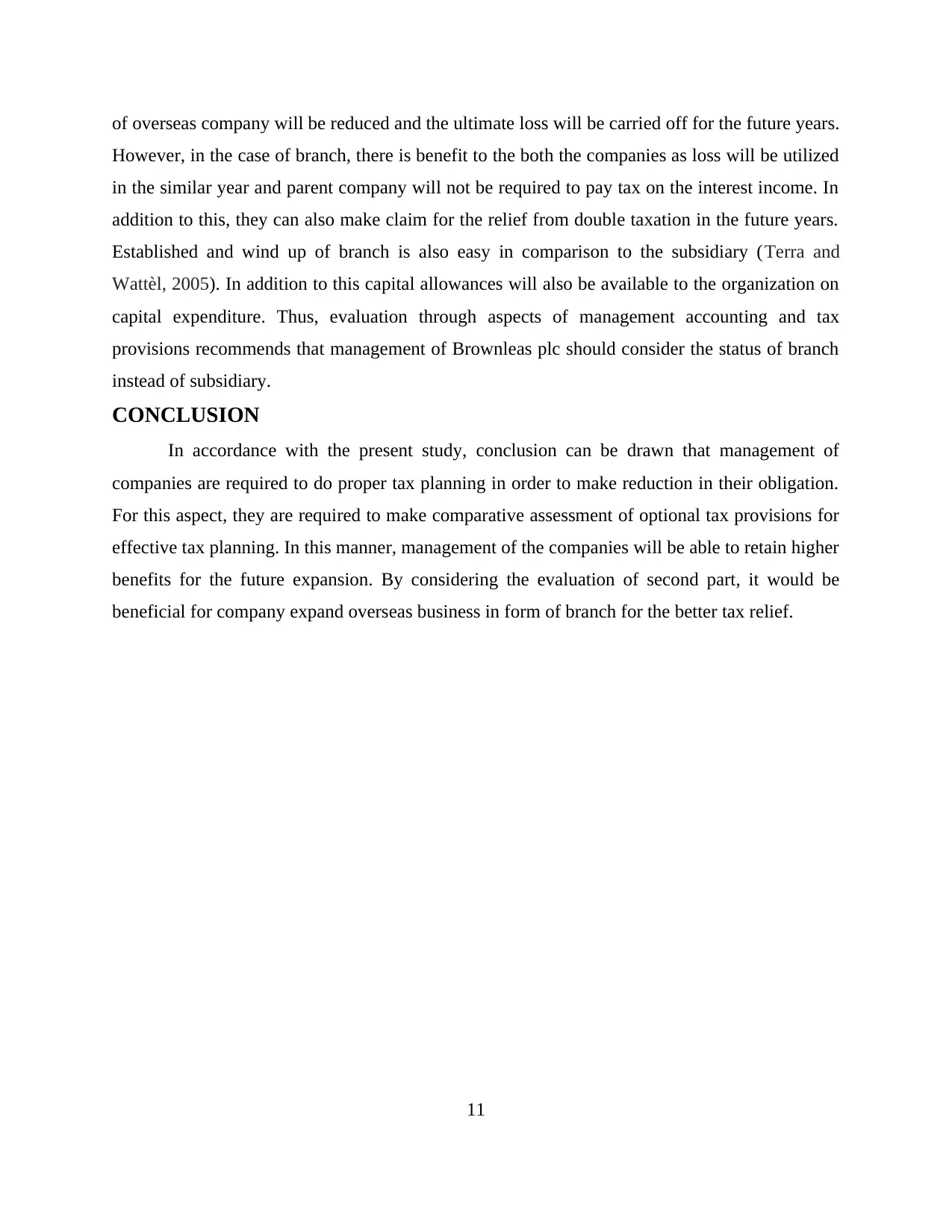
of overseas company will be reduced and the ultimate loss will be carried off for the future years.
However, in the case of branch, there is benefit to the both the companies as loss will be utilized
in the similar year and parent company will not be required to pay tax on the interest income. In
addition to this, they can also make claim for the relief from double taxation in the future years.
Established and wind up of branch is also easy in comparison to the subsidiary (Terra and
Wattèl, 2005 ). In addition to this capital allowances will also be available to the organization on
capital expenditure. Thus, evaluation through aspects of management accounting and tax
provisions recommends that management of Brownleas plc should consider the status of branch
instead of subsidiary.
CONCLUSION
In accordance with the present study, conclusion can be drawn that management of
companies are required to do proper tax planning in order to make reduction in their obligation.
For this aspect, they are required to make comparative assessment of optional tax provisions for
effective tax planning. In this manner, management of the companies will be able to retain higher
benefits for the future expansion. By considering the evaluation of second part, it would be
beneficial for company expand overseas business in form of branch for the better tax relief.
11
However, in the case of branch, there is benefit to the both the companies as loss will be utilized
in the similar year and parent company will not be required to pay tax on the interest income. In
addition to this, they can also make claim for the relief from double taxation in the future years.
Established and wind up of branch is also easy in comparison to the subsidiary (Terra and
Wattèl, 2005 ). In addition to this capital allowances will also be available to the organization on
capital expenditure. Thus, evaluation through aspects of management accounting and tax
provisions recommends that management of Brownleas plc should consider the status of branch
instead of subsidiary.
CONCLUSION
In accordance with the present study, conclusion can be drawn that management of
companies are required to do proper tax planning in order to make reduction in their obligation.
For this aspect, they are required to make comparative assessment of optional tax provisions for
effective tax planning. In this manner, management of the companies will be able to retain higher
benefits for the future expansion. By considering the evaluation of second part, it would be
beneficial for company expand overseas business in form of branch for the better tax relief.
11
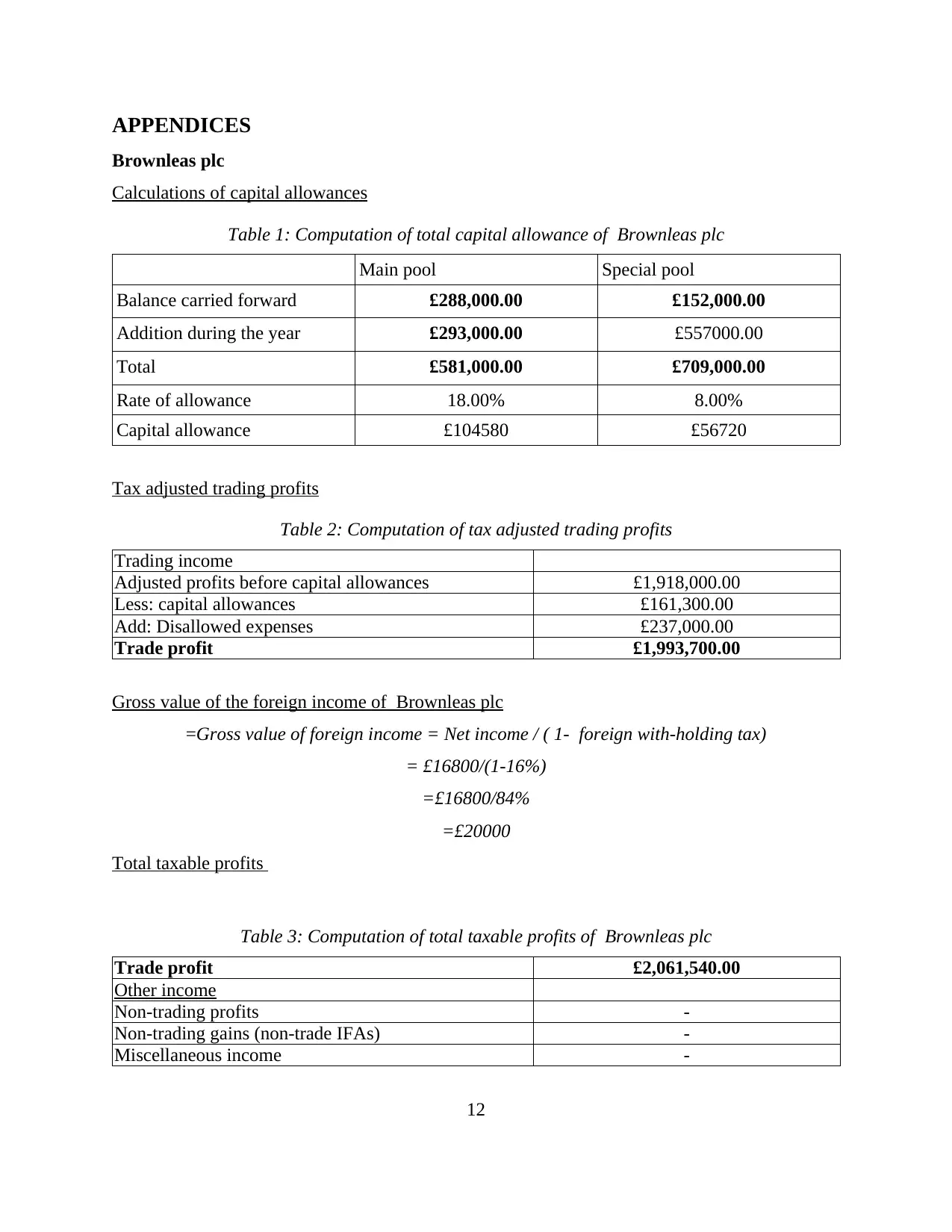
APPENDICES
Brownleas plc
Calculations of capital allowances
Table 1: Computation of total capital allowance of Brownleas plc
Main pool Special pool
Balance carried forward £288,000.00 £152,000.00
Addition during the year £293,000.00 £557000.00
Total £581,000.00 £709,000.00
Rate of allowance 18.00% 8.00%
Capital allowance £104580 £56720
Tax adjusted trading profits
Table 2: Computation of tax adjusted trading profits
Trading income
Adjusted profits before capital allowances £1,918,000.00
Less: capital allowances £161,300.00
Add: Disallowed expenses £237,000.00
Trade profit £1,993,700.00
Gross value of the foreign income of Brownleas plc
=Gross value of foreign income = Net income / ( 1- foreign with-holding tax)
= £16800/(1-16%)
=£16800/84%
=£20000
Total taxable profits
Table 3: Computation of total taxable profits of Brownleas plc
Trade profit £2,061,540.00
Other income
Non-trading profits -
Non-trading gains (non-trade IFAs) -
Miscellaneous income -
12
Brownleas plc
Calculations of capital allowances
Table 1: Computation of total capital allowance of Brownleas plc
Main pool Special pool
Balance carried forward £288,000.00 £152,000.00
Addition during the year £293,000.00 £557000.00
Total £581,000.00 £709,000.00
Rate of allowance 18.00% 8.00%
Capital allowance £104580 £56720
Tax adjusted trading profits
Table 2: Computation of tax adjusted trading profits
Trading income
Adjusted profits before capital allowances £1,918,000.00
Less: capital allowances £161,300.00
Add: Disallowed expenses £237,000.00
Trade profit £1,993,700.00
Gross value of the foreign income of Brownleas plc
=Gross value of foreign income = Net income / ( 1- foreign with-holding tax)
= £16800/(1-16%)
=£16800/84%
=£20000
Total taxable profits
Table 3: Computation of total taxable profits of Brownleas plc
Trade profit £2,061,540.00
Other income
Non-trading profits -
Non-trading gains (non-trade IFAs) -
Miscellaneous income -
12
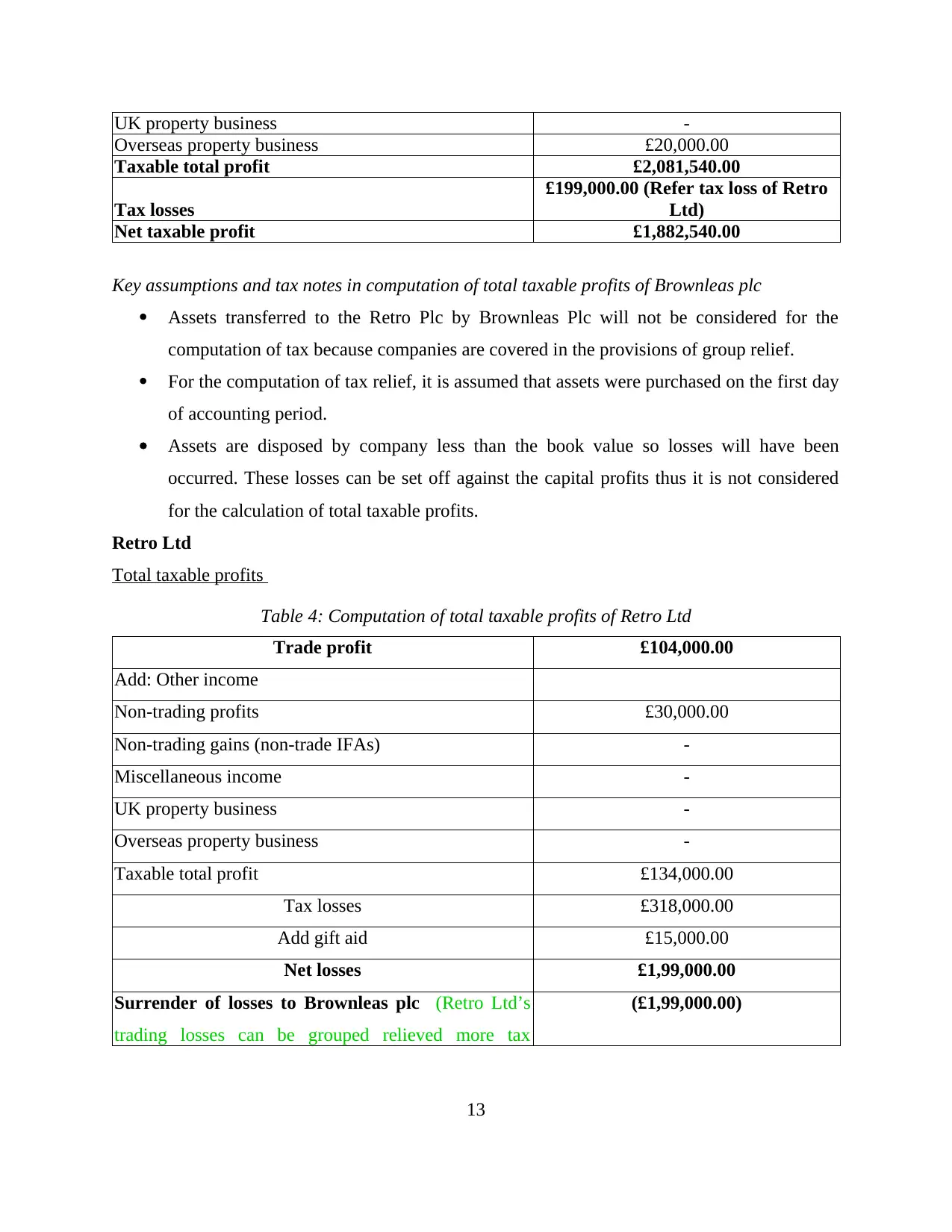
UK property business -
Overseas property business £20,000.00
Taxable total profit £2,081,540.00
Tax losses
£199,000.00 (Refer tax loss of Retro
Ltd)
Net taxable profit £1,882,540.00
Key assumptions and tax notes in computation of total taxable profits of Brownleas plc
Assets transferred to the Retro Plc by Brownleas Plc will not be considered for the
computation of tax because companies are covered in the provisions of group relief.
For the computation of tax relief, it is assumed that assets were purchased on the first day
of accounting period.
Assets are disposed by company less than the book value so losses will have been
occurred. These losses can be set off against the capital profits thus it is not considered
for the calculation of total taxable profits.
Retro Ltd
Total taxable profits
Table 4: Computation of total taxable profits of Retro Ltd
Trade profit £104,000.00
Add: Other income
Non-trading profits £30,000.00
Non-trading gains (non-trade IFAs) -
Miscellaneous income -
UK property business -
Overseas property business -
Taxable total profit £134,000.00
Tax losses £318,000.00
Add gift aid £15,000.00
Net losses £1,99,000.00
Surrender of losses to Brownleas plc (Retro Ltd’s
trading losses can be grouped relieved more tax
(£1,99,000.00)
13
Overseas property business £20,000.00
Taxable total profit £2,081,540.00
Tax losses
£199,000.00 (Refer tax loss of Retro
Ltd)
Net taxable profit £1,882,540.00
Key assumptions and tax notes in computation of total taxable profits of Brownleas plc
Assets transferred to the Retro Plc by Brownleas Plc will not be considered for the
computation of tax because companies are covered in the provisions of group relief.
For the computation of tax relief, it is assumed that assets were purchased on the first day
of accounting period.
Assets are disposed by company less than the book value so losses will have been
occurred. These losses can be set off against the capital profits thus it is not considered
for the calculation of total taxable profits.
Retro Ltd
Total taxable profits
Table 4: Computation of total taxable profits of Retro Ltd
Trade profit £104,000.00
Add: Other income
Non-trading profits £30,000.00
Non-trading gains (non-trade IFAs) -
Miscellaneous income -
UK property business -
Overseas property business -
Taxable total profit £134,000.00
Tax losses £318,000.00
Add gift aid £15,000.00
Net losses £1,99,000.00
Surrender of losses to Brownleas plc (Retro Ltd’s
trading losses can be grouped relieved more tax
(£1,99,000.00)
13
Paraphrase This Document
Need a fresh take? Get an instant paraphrase of this document with our AI Paraphraser

efficiently consider calculation of tax of Brownleas
Plc)
Net losses carried forward -
14
Plc)
Net losses carried forward -
14
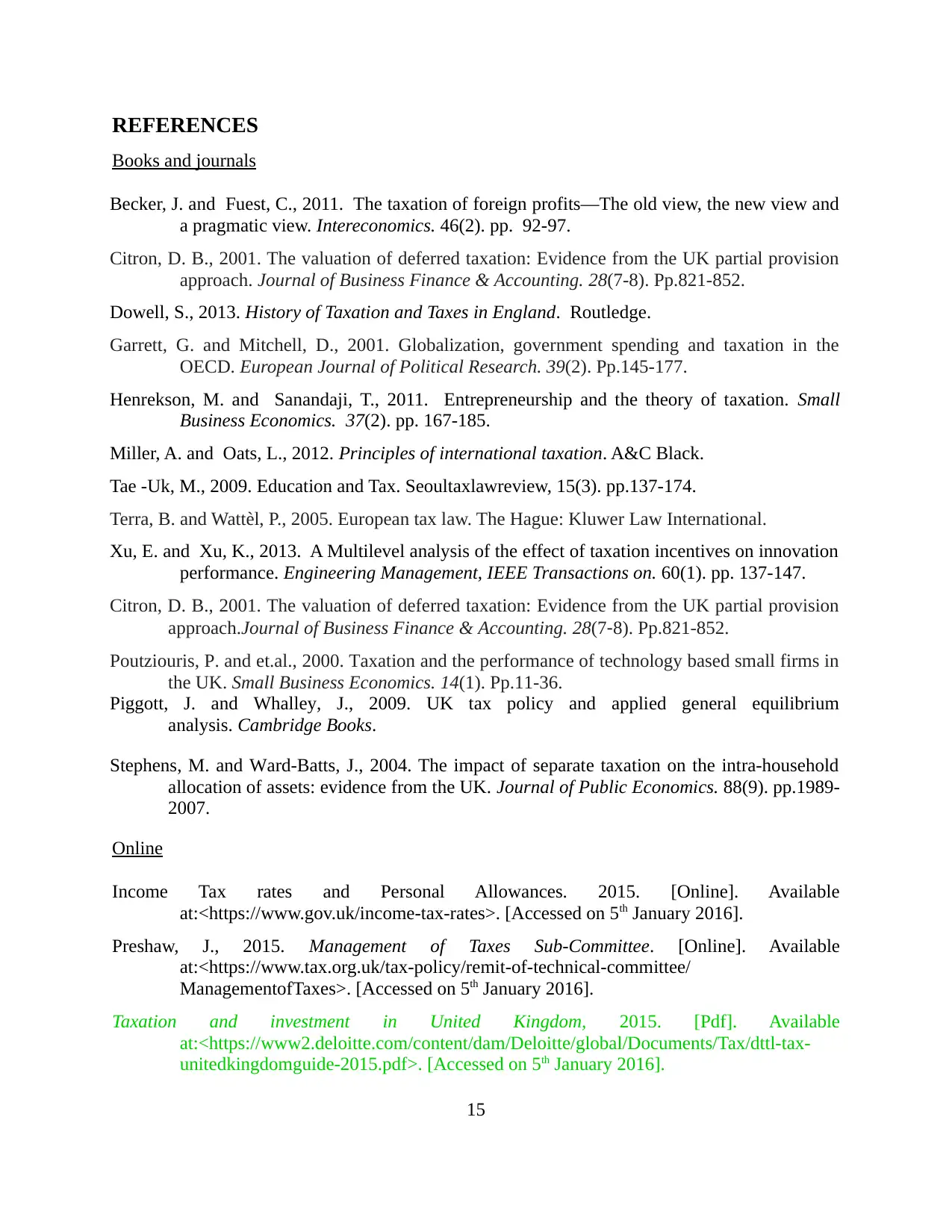
REFERENCES
Books and journals
Becker, J. and Fuest, C., 2011. The taxation of foreign profits—The old view, the new view and
a pragmatic view. Intereconomics. 46(2). pp. 92-97.
Citron, D. B., 2001. The valuation of deferred taxation: Evidence from the UK partial provision
approach. Journal of Business Finance & Accounting. 28(7‐8). Pp.821-852.
Dowell, S., 2013. History of Taxation and Taxes in England. Routledge.
Garrett, G. and Mitchell, D., 2001. Globalization, government spending and taxation in the
OECD. European Journal of Political Research. 39(2). Pp.145-177.
Henrekson, M. and Sanandaji, T., 2011. Entrepreneurship and the theory of taxation. Small
Business Economics. 37(2). pp. 167-185.
Miller, A. and Oats, L., 2012. Principles of international taxation. A&C Black.
Tae -Uk, M., 2009. Education and Tax. Seoultaxlawreview, 15(3). pp.137-174.
Terra, B. and Wattèl, P., 2005. European tax law. The Hague: Kluwer Law International.
Xu, E. and Xu, K., 2013. A Multilevel analysis of the effect of taxation incentives on innovation
performance. Engineering Management, IEEE Transactions on. 60(1). pp. 137-147.
Citron, D. B., 2001. The valuation of deferred taxation: Evidence from the UK partial provision
approach.Journal of Business Finance & Accounting. 28(7‐8). Pp.821-852.
Poutziouris, P. and et.al., 2000. Taxation and the performance of technology based small firms in
the UK. Small Business Economics. 14(1). Pp.11-36.
Piggott, J. and Whalley, J., 2009. UK tax policy and applied general equilibrium
analysis. Cambridge Books.
Stephens, M. and Ward-Batts, J., 2004. The impact of separate taxation on the intra-household
allocation of assets: evidence from the UK. Journal of Public Economics. 88(9). pp.1989-
2007.
Online
Income Tax rates and Personal Allowances. 2015. [Online]. Available
at:<https://www.gov.uk/income-tax-rates>. [Accessed on 5th January 2016].
Preshaw, J., 2015. Management of Taxes Sub-Committee. [Online]. Available
at:<https://www.tax.org.uk/tax-policy/remit-of-technical-committee/
ManagementofTaxes>. [Accessed on 5th January 2016].
Taxation and investment in United Kingdom, 2015. [Pdf]. Available
at:<https://www2.deloitte.com/content/dam/Deloitte/global/Documents/Tax/dttl-tax-
unitedkingdomguide-2015.pdf>. [Accessed on 5th January 2016].
15
Books and journals
Becker, J. and Fuest, C., 2011. The taxation of foreign profits—The old view, the new view and
a pragmatic view. Intereconomics. 46(2). pp. 92-97.
Citron, D. B., 2001. The valuation of deferred taxation: Evidence from the UK partial provision
approach. Journal of Business Finance & Accounting. 28(7‐8). Pp.821-852.
Dowell, S., 2013. History of Taxation and Taxes in England. Routledge.
Garrett, G. and Mitchell, D., 2001. Globalization, government spending and taxation in the
OECD. European Journal of Political Research. 39(2). Pp.145-177.
Henrekson, M. and Sanandaji, T., 2011. Entrepreneurship and the theory of taxation. Small
Business Economics. 37(2). pp. 167-185.
Miller, A. and Oats, L., 2012. Principles of international taxation. A&C Black.
Tae -Uk, M., 2009. Education and Tax. Seoultaxlawreview, 15(3). pp.137-174.
Terra, B. and Wattèl, P., 2005. European tax law. The Hague: Kluwer Law International.
Xu, E. and Xu, K., 2013. A Multilevel analysis of the effect of taxation incentives on innovation
performance. Engineering Management, IEEE Transactions on. 60(1). pp. 137-147.
Citron, D. B., 2001. The valuation of deferred taxation: Evidence from the UK partial provision
approach.Journal of Business Finance & Accounting. 28(7‐8). Pp.821-852.
Poutziouris, P. and et.al., 2000. Taxation and the performance of technology based small firms in
the UK. Small Business Economics. 14(1). Pp.11-36.
Piggott, J. and Whalley, J., 2009. UK tax policy and applied general equilibrium
analysis. Cambridge Books.
Stephens, M. and Ward-Batts, J., 2004. The impact of separate taxation on the intra-household
allocation of assets: evidence from the UK. Journal of Public Economics. 88(9). pp.1989-
2007.
Online
Income Tax rates and Personal Allowances. 2015. [Online]. Available
at:<https://www.gov.uk/income-tax-rates>. [Accessed on 5th January 2016].
Preshaw, J., 2015. Management of Taxes Sub-Committee. [Online]. Available
at:<https://www.tax.org.uk/tax-policy/remit-of-technical-committee/
ManagementofTaxes>. [Accessed on 5th January 2016].
Taxation and investment in United Kingdom, 2015. [Pdf]. Available
at:<https://www2.deloitte.com/content/dam/Deloitte/global/Documents/Tax/dttl-tax-
unitedkingdomguide-2015.pdf>. [Accessed on 5th January 2016].
15
1 out of 15
Related Documents
Your All-in-One AI-Powered Toolkit for Academic Success.
+13062052269
info@desklib.com
Available 24*7 on WhatsApp / Email
![[object Object]](/_next/static/media/star-bottom.7253800d.svg)
Unlock your academic potential
© 2024 | Zucol Services PVT LTD | All rights reserved.





